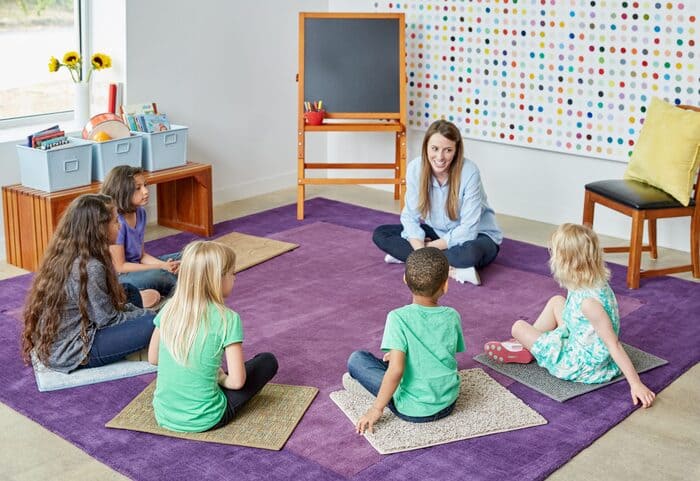15 Amazing Facts About Finland's Education System
 Schooladvisor Team
Schooladvisor TeamFinland was recently named the Happiest Country in the world by the United Nations World Happiness Report, for the fourth time in a row. One of Finland’s attractions is their education system. Its unorthodox education system is deemed to be one of the best in the world simply by going against the evaluation-driven, centralised model that many countries use.
Here's 15 facts you probably didn't know about the Finnish education system.
1. Children don't start school until they are 7 years old.

Photo by S&B Vonlanthen on Unsplash
Children are only required to go to school when they are 7 years old, although there is an option to attend preschool. Finland's education system encourages children to be creative and resourceful by giving them the freedom to learn beyond the formal curriculum at a young age.
2. Unlike other systems, Finnish students only have to sit for a centralised exam at the age of 16.
The students will sit for an exam known as the Finnish matriculation examination to qualify them to enter university. But throughout their 9 years of mandatory schooling (yes, you read that right, 9 years only!), they are not pressured over a test-based system. There's also little homework!
3. All children, regardless of capability, are taught in one classroom.

Photo by HiMama Blog
To ensure that children with learning or behavioral disabilities who are struggling don't fall behind, schools hire teaching aids who undergo an extra year of education to supplement teacher's efforts.
4. Children in Finland are not measured at all during the first six years of their education.

While students in other countries struggle to score in exams every school term, the Finns are free from exam pressure. This is because exams and tests are not weighted until the students are in their teenage years.
5. The government pays for the children to learn.

Photo by jinyun on Unsplash
Yes, we know. Sounds crazy, right? But that is a fact. The students in Finland are provided a monthly allowance of about 500 euros by the government, on top of receiving free education, which usually cost the Americans up to USD$70,000 per year.
6. 93% of Finns graduate high school.

Photo by Good Free Photos on Unsplash
Graduating from high school is an important milestone for a teenager. The high rate of high school graduation goes to show that Finnish education prioritises quality education for students which lowers the possibility of school dropouts.
7. 43% attend vocational school.

Photo by Institute of Entrepreneurship Development
At the age of 16, students can decide if they want to attend the Finnish equivalent of high school to prepare them for university or enter vocational training.
8. Students learn more languages in school.

Photo by Linguistic Society of America
Finnish language education begins on the first day of school. By 9 years old, students begin Swedish (Finland's second official language) and at 11, they start learning a third language, usually English. Many students even take on a fourth language around the age of 13. Students are tested on their first two languages in a matriculation exam for university placement.
9. Elementary school students get 75 minutes of recess a day in Finland versus an average of 27 minutes in the US.

Besides getting generous hours of recess, the students also receive a 15-minute break after every lesson. Furthermore, outdoor physical activity is highly encouraged and some lessons are taught outside of the classroom.
10. Teachers only spend 4 hours a day in the classroom and take 2 hours a week for professional development.

Photo by FatCamera on iStock
Teachers spend at least two hours on building curriculum and assessing student progress on a weekly basis. With fewer teaching hours, students are not overwhelmed with class, and teachers are not struggling to prepare.
11. The national curriculum is only a broad guideline.

Photo by Mohawk Home
Teachers have the freedom of deciding the best educational methods for their students. Teachers are given guidelines for what they have to teach, but they are not given prescriptions for how to teach it. This allows the highly trained teachers to develop a curriculum geared towards teaching their unique group of students.
12. All teachers in Finland must have a master's degree, which is fully subsidised.

Photo by Shutterstock
You need more than a bachelor's degree and a teaching certificate to teach in Finland. Teachers need to have top academic credentials in order for them to be able to plan quality curriculum and assessment for their students.
13. Teachers are selected from the top 10% of graduates.
In many countries, it may be easy for one to become a teacher. However, that is not the case with Finland as it is easier to be a lawyer or a doctor in the country as compared to being a teacher. Even when you are qualified to be a teacher, you have to compete to be at the top 10% of graduates in order to be selected as one.
14. Teachers are effectively given the same status as doctors and lawyers.

Photo by bienchen-s on Freepik
Unlike in most countries, the profession of a teacher is underestimated and looked down upon. Teachers in Finland are highly educated and they are regarded as respected professionals. Their status is equivalent to that of lawyers and doctors.
15. Teachers stick with students.

Photo by All Education Schools
In most countries (Malaysia included), students get a new teacher every year. In Finland, a teacher is more likely to stick with the same group of students for five years. This gives teachers the opportunity to bond with their students and also to better know students as learners.
Despite the pandemic’s devastation, Finland remains the happiest country in the world. These amazing facts about Finland's education system show how the country prioritises the well-being and development of its people. Instead of stressing over exams every now and then, the students are able to focus on truly learning about life skills that will be beneficial for their future.
Recent Articles
- What Should You Be Looking for in a Preschool?
- HELP Education Group Unveils New Sports Oval in Subang 2 Campus
- Exploring the Homeschooling Path: What Parents Need to Know Before Taking the Leap
- More Parents Are Now Opting for International Schools in Malaysia
- AISM Students Who Dream Big and Build Bigger

